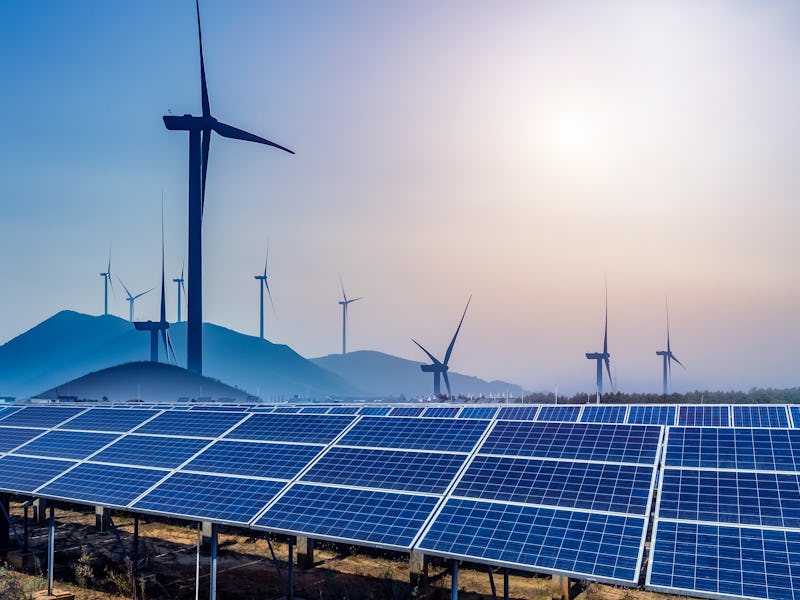Scientists discover 'holy grail' approach to renewable energy
Using supercomputers to find the needle in the energy haystack.

What do you get when you combine a chemist, theoretical physicist, and a supercomputer? An efficient, computational approach to designing optimized renewable energy storage from sources like wind and solar, say researchers.
A new study published Friday in Nature Communications describes an approach that allows researchers to compare and contrast different chemical catalysts in order to find a compound that would be cost-effective and efficient for creating renewable electricity through a common process called electrolysis. During electrolysis, water is broken into its respective parts, oxygen and hydrogen, in order to create a green source of energy in the form of H2.
Electrolysis itself isn’t new, but current catalysts used to spark this reaction are either too expensive or cheaper options suffer from a lack of efficiency, the authors said in a statement.
While their approach doesn’t necessarily identify the perfect catalyst, it provides a useful tool for future researchers to drastically narrow down that search space, Max García-Melchor, Assistant Professor in Chemistry at Trinity and senior author, said in a statement.
“Given the increasingly pressing need to find green energy solutions it is no surprise that scientists have, for some time, been hunting for a magical catalyst that would allow us to split water electrochemically in a cost-effective, reliable way,” said García-Melchor. “However, it is no exaggeration to say that before now such a hunt was akin to looking for a needle in a haystack. We are not over the finishing line yet, but we have significantly reduced the size of the haystack and we are convinced that artificial intelligence will help us hoover up plenty of the remaining hay.”
The authors write that a large part of this narrowing process was done by re-examining traditional beliefs about catalysts and the obstacles they face. Traditionally, catalyst researchers have stayed away from molecules that they believed required too much extra energy (referred to as “overpotential”) to spark the reaction process.
This balancing act can be tricky, lead author, Michael Craig, told Inverse
“The goal is to produce hydrogen from water,” Craig says. “but the reaction which produces oxygen needs to happen at the same time, and is more difficult.”
After the team began looking more closely at certain oxygen-rich molecules, they noticed that other research had been underestimating the reactivity of these catalysts. They would have enough energy to complete the reaction without extra voltage.
The authors write that redefining these search principles for catalysts could help future researchers more effectively find and use previously underutilized compounds. Craig said in a statement write that they hope this can help researchers in their search for the “green bullet” catalyst to ultimately optimize these green energy processes.
“We know what we need to optimise now, so it is just a case of finding the right combinations,” said Craig.
He continued to tell Inverse that cheap metals like iron and manganese showed unique potential.
“The most important guideline highlights that abundant, cheap metals, such as iron and manganese, have a unique ability to exhibit the proposed low overpotential,” says Craig. “[And] a small reduction in the overpotential represents a gargantuan increase in the output of your desired product.”
(L) Professor Max Garcia-Melchor and (R) Ph.D. Candidate, Michael Craig hope that their approach can help optimize renewable energy creation and storage.
A primary target of this catalyst research is commercial grade water electrolyzers such as wind turbines and solar panels which generate electricity that could be used to drive water electrolysis to generate H2 fuel. The authors write that this H2 could be stored and used as an energy source in fuel cells for times when the turbines and solar panels aren’t in use, like cloudy or less windy days.
Solar and wind power have already been proven to be more economical in many ways than fossil fuels, but when it comes to decreasing dependence on fossil fuels, finding ways to make renewable approaches convenient as well will also be important.
According to a 2019 “Global Energy Outlook” report, even under “Ambitious Climate Scenarios” renewables are only likely to make up 31 percent of energy production by 2040. Learning how to better store this energy through approaches shown in this research could make important strides towards such renewables being more universal and widely used.
García-Melchor writes that he hopes their research can be a part of that.
“This research is hugely exciting for a number of reasons and it would be incredible to play a role in making the world a more sustainable place,” said García-Melchor. “Additionally, this shows what can happen when researchers from different disciplines come together to apply their expertise to try to solve a problem that affects each and every one of us.”
Read the abstract here:
A major roadblock in realizing large-scale production of hydrogen via electrochemical water splitting is the cost and inefficiency of current catalysts for the oxygen evolution reaction (OER). Computational research has driven important developments in understanding and designing heterogeneous OER catalysts using linear scaling relationships in reaction binding energies. Herein, we interrogate 17 of the most active molecular OER catalysts, based on different transition metals (Ru, Mn, Fe, Co, Ni, and Cu), and show they obey similar scaling relations to those established for heterogeneous systems. However, we find that the conventional OER descriptor underestimates the activity for very active OER complexes as the standard approach neglects a crucial one-electron oxidation that many molecular catalysts undergo prior to O–O bond formation. Importantly, this additional step allows molecular catalysts to circumvent the “overpotential wall”, leading to enhanced performance. With this knowledge, we establish fundamental principles for the design of ideal OER catalysts.